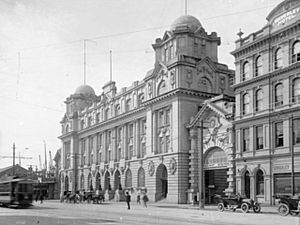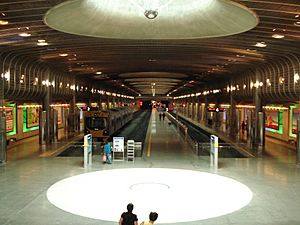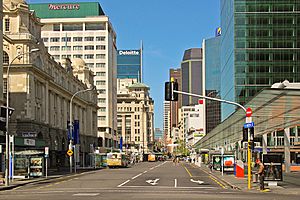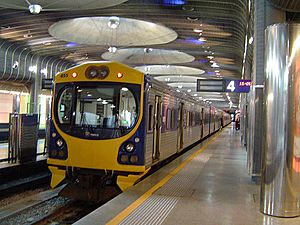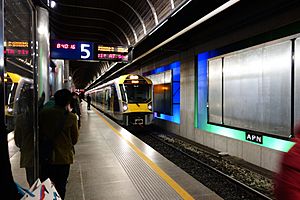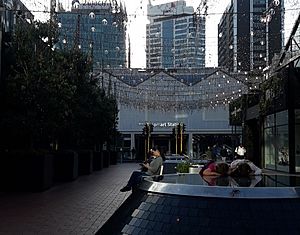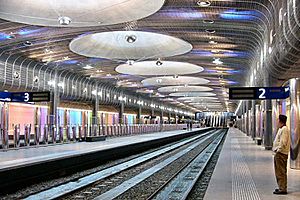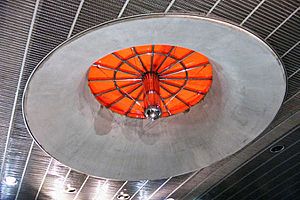Britomart Transport Centre facts for kids
Quick facts for kids
Britomart Transport Centre
|
|||||||||||||||||||||||
|---|---|---|---|---|---|---|---|---|---|---|---|---|---|---|---|---|---|---|---|---|---|---|---|
| Auckland Transport Urban rail | |||||||||||||||||||||||

An EMU arrives at the newly electrified Britomart station, 2014.
|
|||||||||||||||||||||||
| Location | Auckland CBD | ||||||||||||||||||||||
| Owned by | Auckland Transport | ||||||||||||||||||||||
| Line(s) | North Island Main Trunk | ||||||||||||||||||||||
| Platforms | 5 | ||||||||||||||||||||||
| Tracks | 2 | ||||||||||||||||||||||
| Construction | |||||||||||||||||||||||
| Structure type | Underground | ||||||||||||||||||||||
| Platform levels | 1 | ||||||||||||||||||||||
| Bicycle facilities | Yes | ||||||||||||||||||||||
| Other information | |||||||||||||||||||||||
| Station code | BMT / AKL | ||||||||||||||||||||||
| Fare zone | City | ||||||||||||||||||||||
| History | |||||||||||||||||||||||
| Opened | 7 July 2003 | ||||||||||||||||||||||
| Electrified | 25 kV AC (2014) | ||||||||||||||||||||||
| Traffic | |||||||||||||||||||||||
| Passengers (CY 2018) | 10,224,759 | ||||||||||||||||||||||
| Services | |||||||||||||||||||||||
|
|||||||||||||||||||||||
| Designated: | 11 July 1986 | ||||||||||||||||||||||
| Reference #: | 101 | ||||||||||||||||||||||
The Britomart Transport Centre is a super important place for public transport in Auckland, New Zealand. It's like a main station where trains, buses, and ferries all connect in the city centre. It's built inside an old, grand post office building, mixed with cool, modern designs. You'll find a train station and a bus station here.
It's right at the bottom of Queen Street, Auckland's main shopping street, and the ferry terminal is just across Quay Street. Building Britomart took a lot of planning! People had many ideas, some much bigger, but they chose a plan that worked best for the cost and space.
When it opened in the early 2000s, it was Auckland's biggest transport project ever. It was built to bring train access closer to the city centre. This also helped more people use public transport. Britomart is one of the few underground train stations in the world designed for diesel trains.
At first, some people thought it was too expensive and not used enough. But now, it's a huge success! More and more people are using trains, and Britomart is getting very busy. The main challenge is that the tunnel leading to it only has two train tracks. Also, there isn't a direct train link through the station to other parts of Auckland. A new tunnel, called the City Rail Link, is now being built to fix this.
Contents
History of Britomart
How Britomart Started
Britomart is built on land that was once part of the sea, called Commercial Bay. It gets its name from Point Britomart, a headland that was once nearby. In the 1870s and 1880s, this headland was flattened. Its soil was used to fill in Commercial Bay, making space to extend the railway line. This brought the trains closer to the bottom of Queen Street.
The main Auckland Railway Station moved to Britomart in 1885. It stayed there even after the Post Office building was built in 1911. In 1930, the station moved again, about 1.2 kilometres east. The old station site then became a bus terminal in 1937 and a car park in 1958.
Many ideas came up to bring the station back to the city centre. In the 1970s, the Mayor of Auckland, Dove-Myer Robinson, wanted an underground station at Britomart. He also wanted a tunnel loop for trains. But the government at the time stopped this plan, saying it was too costly.
In 1995, the Auckland City Council bought the old Post Office building. They planned to turn the area into a modern transport hub.
Building Britomart
Planning and Design
Early plans for Britomart suggested putting both the bus terminal and the railway underground. However, these ideas were changed. People preferred buses to be above ground, and the costs for underground buses became too high. This was partly because of problems with water getting in.
In 1998, a cheaper plan was chosen after talking with many people. The design was picked through a competition. It used part of Queen Elizabeth II Square and nearby streets for buses. The old bus terminal was rebuilt to include bus services and a walking area. A tunnel for the underground railway link was built in 2000.
Construction Details
Building Britomart started in October 2001. It was designed by Mario Madayag from California, working with local architects Jasmax. The project involved digging out a huge amount of earth, about 200,000 cubic metres! They also poured 40,000 cubic metres of concrete.
Workers installed 14 kilometres of piles, some going 40 metres deep. These piles help protect the station from earthquakes. They also make sure the area is ready for future buildings to be built on top of the station. About 2 kilometres of new train tracks were laid. Half of these tracks are in a special tunnel built by digging a trench and then covering it.
The station officially opened to passengers on 7 July 2003. Sir Edmund Hillary and government officials celebrated the grand opening on 25 July 2003. After Britomart opened, most train services moved there.
Britomart cost NZ$204 million, which was a lot of money. Some people thought it was too expensive. But despite this, it has won many awards for its design. It's known around the world for its new and interesting architecture that still respects the old buildings.
Pedestrian Walkways
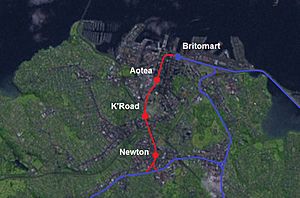
Original plans for Britomart included underground walkways for people. These would connect to Queen Elizabeth II Square, the ferry terminal, and Queen Street. But because of high costs, only a short walkway under Queen Street was built. Instead of more tunnels, a large rain-proof canopy was built above ground. This canopy stretched from the square towards the ferry terminal and Queen Street.
The underground walkway was closed in 2016 to make way for the City Rail Link project. The canopy was also taken down. In May 2016, the Downtown Shopping Centre nearby was closed and demolished.
Recent Changes
In January 2017, the main Britomart station building was closed for major work. A new, temporary station building was opened at the back. This temporary building was used for three years. The original building is being fixed up and made stronger. This is important because the City Rail Link tunnels will go right underneath it.
To dig the trenches for the City Rail Link, the Downtown Shopping Centre was demolished in 2016. It has been replaced by a new area called 'Commercial Bay'. This new area includes a tall skyscraper and a shopping centre. The Auckland Council and the property owners agreed to build the City Rail Link tunnels directly under these new buildings.
On 6 April 2021, the main Britomart building (the old Central Post Office) was reopened. The mayor, Phil Goff, and many people attended the opening ceremony.
Britomart's Capacity and Connections
Britomart was designed to handle up to 10,500 passengers during busy times. To increase its capacity even more, Britomart needs to become a "through station." This means trains would be able to go straight through the station instead of having to turn around. A new tunnel under Auckland's city centre, called the City Rail Link, will make this possible.
The station has five platforms. It is limited by the size of its main access tunnel, which is 426 metres long and only 9.3 metres wide. This tunnel has only two tracks. Experts thought the tunnel would reach its maximum capacity around 2020. However, more people started using trains, and the tunnel reached its limit almost 10 years earlier, in 2011!
More Train Services
When Britomart first opened, some people criticised it. They felt it was too big and grand for the number of trains and passengers at the time. But train use in Auckland has grown a lot! In 2003, there were 2.5 million train journeys. By 2017, this had jumped to 19 million journeys!
Electrification
In 2007, it was announced that Auckland's train network would be electrified. This meant installing overhead wires to power electric trains. Auckland Transport bought new electric trains to replace the old diesel ones.
Britomart officially became an electric station on 31 March 2014. The Prime Minister, John Key, helped celebrate this event. The first electric passenger trains started running four weeks later, on 28 April 2014.
By July 2015, all local trains using Britomart were electric. Only the long-distance Northern Explorer train still used diesel. By December 2015, Britomart needed an upgrade to its diesel exhaust fans. The company operating the Northern Explorer decided it was too expensive to pay for the upgrade. So, from 21 December 2015, the Northern Explorer stopped using Britomart and moved its Auckland station to The Strand Station.
City Rail Link
For almost a century, people have talked about building a tunnel south from Britomart under the city. With Britomart now open, this tunnel would allow trains to go through the station instead of having to reverse out.
In 2008, planning began for a 3.5-kilometre tunnel. This tunnel would likely go under Albert Street and have three new underground stations. One station would be near Aotea Square, another near Karangahape Road, and a third near Newton. At the southern end, the line would connect to an upgraded station at Mt Eden.
The City Rail Link (CRL) was first estimated to cost around $1 billion and take 5–7 years to build. In 2014, the plan for the Newton station was dropped. Instead, the Mt Eden station would be upgraded. Construction for the CRL began in 2015, with major work starting in 2018.
Once the CRL is finished, Britomart will no longer be a "terminal station." This means trains will be able to travel straight through it.
Eastern Tunnel Capacity
Another idea to increase capacity was to build a second tunnel next to the existing one. This would create four tracks leading into Britomart. It would have cost less than the City Rail Link, but it wouldn't have given the extra benefits of new underground stations or a more direct route.
Even though it was cheaper, this idea wouldn't have solved all the long-term problems. However, it could have been built faster. In 2011, a new system called 'bi-directional signalling' was added to the existing tunnel. This allows a train to leave on the same track it entered, which helps trains move more smoothly and increases capacity.
Services at Britomart
Trains
Transdev operates Auckland's local train network for Auckland Transport. This includes electric train lines that go west to Swanson and south to Onehunga, Manukau, and Papakura. There's also a diesel shuttle service between Papakura and Pukekohe.
In 2015, Britomart could handle 20 trains per hour. On a typical weekday, outside of peak times, eleven trains leave Britomart every hour. These include:
- 3 trains per hour to Manukau (Eastern Line)
- 3 trains per hour to Papakura (Southern Line)
- 3 trains per hour to Swanson (Western Line)
- 2 trains per hour to Onehunga (Onehunga Line)
Buses and Ferries
Britomart is a major place where you can switch between trains, buses, and ferries. Many bus routes start or end here. This includes the SkyBus to Auckland Airport and the Northern Express NX1 route to Albany. The frequent CityLink and InnerLink bus services also stop nearby.
Other buses leave from stops on the streets around Britomart. Until 2016, buses used to arrive and leave from Queen Street right in front of the station. But now, that part of Queen Street is a public plaza for people to walk.
Just across Quay Street from the station is the Auckland Ferry Terminal. This is the main place for Auckland's ferry system. You can catch ferries to nearby suburbs like Devonport and Half Moon Bay. You can also take ferries to islands in the Hauraki Gulf like Waiheke Island and Rangitoto Island.
Heritage Status
The main Britomart building, which was once the Chief Post Office, is a very important historical building. It was officially registered as a Category I heritage building by Heritage New Zealand on 11 July 1986. Its registration number is 101.
Awards Britomart Has Won
Britomart Transport Centre has received many awards for its design and impact:
- 2004 Property Council of New Zealand – Merit Award
- 2004 American Institute of Architecture – International Winner
- 2004 New Zealand Institute of Architects – Resene Award, Community and Cultural
- 2004 New Zealand Institute of Architects – Resene Award, Heritage and Conservation
- 2004 Illuminating Engineering Society of Australia and New Zealand – Lighting Award
- 2004 New Zealand Concrete Society – Concrete Award
- 2005 New Zealand Institute of Architects – Resene New Zealand Award for Architecture, Community & Cultural
- 2007 Kenneth F. Brown Asia Pacific Culture and Architecture Design Award – Honorable mention


